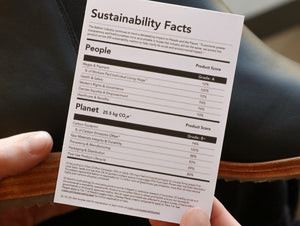Our CEO, Patrick, shares how we came to conclude that lasting change in the fashion industry will only come once we begin to measure the impact of our actions.
How and Why We Measure Impact
Results are louder than actions or words
This year's Fashion Revolution Week marks the 8th anniversary of the Rana Plaza factory collapse in Bangladesh. This historic tragedy claimed the lives of 1,132 factory workers and served as a crucial turning point that led consumers and brands to start getting serious about answering one of the fashion industry’s most closeted questions: “How can the plight of workers at the bottom of the global supply chain be improved?”
Any brand or consumer who is seriously asking this question has already taken the first step toward answering it. Awareness is definitely an important part of progress. But as we know, actions speak louder than words. Most of the proposed solutions to this question today center around safe working conditions, greater transparency, and fair wages. All of these actions are steps forward and are definitely worthy of celebration. That said, if our concern is really about the well-being of the people who make the clothes and shoes we wear everyday, we have to go beyond words or actions and begin to understand whether or not our efforts are actually creating a positive impact. And, the only way we can understand this is by prioritizing the measuring of results because results––whether positive or negative––speak much louder than words or actions.
We at Nisolo do not have the capability of measuring results of the progress that has been made on a global scale over the past eight years since the Rana Plaza factory collapse. However, we can share a little bit about the experience we’ve had growing our own factory in a developing country and how we came to the conclusion that improving the plight of workers at the bottom of the fashion industry’s supply chain must be about more than awareness, more than providing safe working conditions and “fair” or “living” wages, and more than greater transparency.
In this post, I’m going to take you behind the scenes to share how we learned the hard way that unless the brands you love are systematically measuring the results of the actions they are taking toward social and environmental progress, all the positive “impact” (or “empowerment” or “transparency” or however else they may be phrasing it) might be nothing more than greenwashing. And, finally, in hopes that you as consumers as well as other brands can learn from the mistakes we’ve made, I’m going to walk you through exactly how and why we measure our impact.
Why we measure impact
When we started Nisolo in 2011, I falsely assumed that job creation, safe working conditions, and fair wages alone would lead to improved livelihoods for our shoemakers––most of whom come from underserved communities. But, we learned soon after that poverty is much more complex. One of the first metrics that we began to measure was a shoemaker’s change in household income due to beginning to work with us. At that time, the average annual income increase was more than 300%! Inevitably, we were encouraged by the numbers and assumed that such a significant increase must be leading to positive impact and significant changes within the households of our producers.
However, this simply was not true. So, we started to dig in further. We learned that although our shoemakers were receiving a higher income, most had very little understanding of their fixed household expenses or how to manage their finances. This was, in part, rooted in the fact that many of our producers had spent their entire lives managing their finances on a day-to-day, survival-mode basis. Often out of necessity, what came in one day would usually be spent by the next, regardless of the amount. While in some cases this meant impulsive spending, for the vast majority, it was well intentioned. Whether it was helping to build a community center, giving money to ill relatives in need, or lending money to the neighbors down the road to finish constructing their roof, there was always a need that required immediate assistance.
With such an inherent focus on the short-term, we learned that many of our producers were ill-prepared from a planning perspective for more substantial, medium-term expenses that might arise. When it came time to pay school fees and buy books and clothes for their children, many would find themselves seeking loans from dangerous loan sharks charging interest rates as high as 30%. Or, when an unexpected emergency would come about, they would be left vulnerable. Regardless of the income increase, some appeared to be stuck in a cycle of poverty and debt that was rooted in poor planning and financial understanding.
Sadly, the assumption we made that we were having a positive impact was only true at face value. But, out of this emerged a passion to take our impact measurement to the next level and to continue to pivot until we saw positive results from all of our actions.
We can’t measure what we don’t understand
One mistake we made early on was treating our own assumptions about how to positively impact our producers as fact rather than hypotheses. The truth was we did not know our producers or their needs or the challenges they face well enough. That’s why measuring social impact should begin with meeting people where they are. It should start with spending time together and developing authentic, trusting relationships. For this reason, we visit the homes of each of our producers when they start working in our factory so that we can get to know them on a more personal level and better understand the reality they face. Since we began to meticulously measure our social impact back in October of 2014, we’ve spent over 1,000 hours building one on one relationships with our producers and continually learning about their immediate needs, the progress they are making, and the long term goals they have for their families.
At its most basic level, measuring the results of your impact must start with understanding the needs of the group you are hoping to support. Once we ditched our assumptions and started to understand the challenges our producers face on a more intimate level, we could then begin to design an impact strategy that would actually be effective.
The nuts & bolts of our impact assessment
To properly measure social impact, it’s also crucial to design an assessment with thorough metrics that can be tracked over time. The impact assessment that we use was developed in 2015 alongside third party experts and is a hybrid assessment that blends relevant elements of the Poverty Probability and Human Development Index assessments. The bulk of the assessment is a 190 question survey that we conduct in the homes of our producers. The assessment allows our team to record and track information over time such as home/land ownership, living conditions, economic well being, savings and debt levels, access to the formal banking sector, education access for producers and their children, access to professional development opportunities, health and access to proper care, social and psychological wellness, etc.
Utilizing a proper impact assessment has allowed us to challenge our assumptions with raw data and pragmatically evaluate the level of vulnerability of our producers over time. Inevitably, this has enabled our impact programming and strategic decision making to not only be led by intuition but factual numbers as well.
The type of information our assessment teaches us
Our impact assessment teaches us a lot about the circumstances of our producers. We’ve learned that while the majority of our producers in Peru are between the ages of eighteen and twenty nine, 67% of them have children (most of whom are young). 46% of our producers did not have access to routine healthcare before Nisolo, 45% had never held a job with a stable salary prior to joining Nisolo, and over 30% did not finish high school due to the desperate need to contribute to household income earnings from a young age. We’ve learned that only 10% of our producers had access to a bank account prior to joining Nisolo, and that nearly all of them share an expressed need for financial literacy training.
How data affects our approach to impact
We believe the purpose of measuring social impact is to inform and shape programs that both address the core problems our producers face and create results that demonstrate life changing, sustainable impact. Through analyzing assessment data and patterns, we have come to recognize that our producers’ needs fall primarily into three areas: financial literacy, education, and holistic health (physical, emotional, and mental) development.
Our findings have evolved our impact programming for the better. Learning from our assessments and the relationships we’ve built with our producers, our programming now includes initiatives such as trainings on how to budget and save money, what to look out for when soliciting a bank loan, healthy eating, how to utilize the company sponsored healthcare plan, physical fitness, how to reduce stress, etc. And, to provide a safer, more responsible debt option (which is often requested in our assessments), we offer an in-house micro loan program where producers can receive an interest free, short term loan to go toward health emergencies and educational needs. Further responding to the needs of our producers derived from our impact assessment, our programming has evolved to also offer free technical trainings, weekly English classes, and discounts with partner university programs to encourage professional development and ongoing educational opportunities.
The results
A baseline, data-heavy needs assessment is essential when measuring impact and should be the driving force behind the design of impact programming. As explained above, we use the data we collect to continually enhance our programming, but the next step of measuring the results of our programming is just as important. We do this by conducting follow up interviews with our producers every six months to gauge how their households are changing over time based on the decisions they are making and their participation in our impact programming.
Thankfully, the results of the data from these follow-up interviews have been informative and inspiring. Previously in this post, I mentioned that even though some of our shoemakers experienced a 300% income increase after beginning to work with us, they were still not saving any money. Now, after owning the results of our impact measurement and strengthening our programming over time, we are beginning to see a difference in increased savings.
Additionally, producers at large report that they have begun eating healthier after learning about the importance of a balanced diet and physical fitness. And, one of the things we’ve found to be most inspiring is that 86% of our producers have expressed that they are making progress toward accomplishing their ultimate goals in life such as purchasing a home or helping their children obtain a college degree.
These are all great results, and we are excited to see them. However, this will not slow down our willingness to challenge these results over time, always allowing our strategy to pivot based on what the data tells us.
In summary
In our experience, the level of progress that we hoped to see (and that we know our consumers hope to see in the lives of the people who make the products they wear everyday) did not occur simply by providing a stable job, safe working conditions, and a fair or living wage. Complex issues rarely have cure-all, simple solutions. Results like these have only come from getting serious about how we think about impact, how we measure it, how we track it, and how we let the data inform our decision making.
We have learned that real transformation takes place when brands make a long term commitment to the communities and ecosystems they source from and when brands go the extra mile to assess how they can ensure the best possible quality of life for the people within their supply chain. With this in mind, our hope is that the conversation around how to best improve the plight of workers at the bottom of the global supply chain of the fashion industry will soon move beyond awareness, beyond actions like living wages (though they are both important pieces of the puzzle!), and will soon include a pragmatic focus on measuring impact so that approaches will strengthen and positive results can become widespread.
Cheers to our producers and cheers to you
I talked a lot in this post about the work that “we” do. Please do not walk away with the wrong impression here. In order to share our experience and explain how “we” at Nisolo measure impact, I had to use a lot of personal pronouns. That said, at the end of the day, “we” at Nisolo are just facilitators. The real impact that is occurring within the Nisolo community is a result of the effort and decisions our producers have made themselves. This impact has resulted from the meticulous care and passion they put into making beautiful products, and this impact has resulted because of YOU, the consumer, who believes in what we stand for as a brand.
Looking ahead
Our lives are interconnected. A decision here has a direct impact there. You and I have the power to shift the fashion industry in a better direction only if we continually evaluate the impact our products have on people and the planet. There are over 100 million people around the world working in the fashion industry’s supply chain. What would it look like if brands and consumers committed the time and resources to understand their impact on these individuals and their communities? Could the fashion industry become a mass vehicle helping millions of people grow out of the vicious cycle of poverty?
Patrick Woodyard
Nisolo Founder & CEO




























